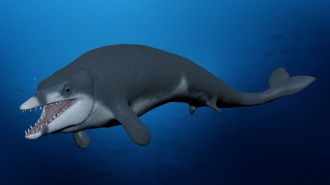Uncategorized
-
 Physics
PhysicsHow to run a marathon in under two hours
Running between other people reduces air resistance. A new study identifies optimal positioning of such drafting formations. Watch out, marathon records.
-
 Neuroscience
NeuroscienceNeuroscientists decoded a Pink Floyd song using people’s brain activity
The technique could be used to improve devices that allow communication from people unable to speak.
-
 Animals
AnimalsMacaques in Puerto Rico learned to share shade after Hurricane Maria
Animals that spent more time together on hot afternoons were less likely to die during the years following the storm, a new study finds.
-
 Health & Medicine
Health & MedicineWhy are more people under 50 getting colorectal cancer? Scientists have some clues
Science News spoke with doctors about their research into early-onset colorectal cancer. Here’s what they’re learning and what questions remain.
By Meghan Rosen -
 Life
LifeMany frogs glow in blue light, and it may be a secret, eerie language
Biofluorescence is far more common across frog species than previously thought. The faint twilight glow could have a role in communication or mating.
By Jake Buehler -
 Climate
ClimateNature’s changing colors makes climate change visible
The world’s color palette is shifting in response to climate change. Seeing these changes in nature firsthand is a powerful communication tool.
By Sujata Gupta -

Extreme weather threatens human health worldwide
Editor in chief Nancy Shute discusses how extreme heat waves and wildfires are harming human health around the world.
By Nancy Shute -

-
 Particle Physics
Particle PhysicsThere’s a new measurement of muon magnetism. What it means isn’t clear
The measurement, from the Muon g−2 experiment, is the most precise yet. But recent theoretical predictions are a bit muddled.
-
 Paleontology
PaleontologyMeet the tiny ancient whale named after King Tut
The newly discovered Tutcetus rayanensis lived about 40 million years ago. It was just 2.5 meters long and weighed less than 200 kilograms.
By Skyler Ware -
 Astronomy
AstronomyMeet Jane Rigby, senior project scientist for JWST and advocate for LGBTQ+ astronomers
Rigby, senior project scientist for the James Webb Space Telescope, believes being part of the LGBTQ+ community has made her a better astronomer.
-
 Plants
PlantsThe fastest-evolving moss in the world may not adapt to climate change
The genus Takakia has the largest number of fast-evolving genes of any moss, a study finds. But it’s losing ground in the warming Himalayas.